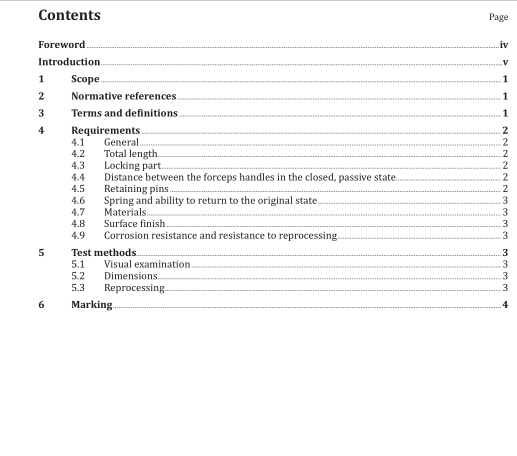ISO 16635-2:2014 pdf download.Dentistry — Dental rubber dam instruments — Part 2: Clamp forceps
4 Requirements
4.1 General
In accordance with its intended use, a clamp forceps shall be designed such that it can be used to apply the dental rubber dam clamp across the row of teeth without the forceps coming into contact with the teeth.
This requires that the working end with the retaining pins is angled against the handle and/or stepped.
The retaining pins shall be provided with a depth-control stop to ensure that they can only be inserted to a certain depth into the hole in the clamp and that the clamp can be safely orientated in three spatial directions while the forceps is applied to the tooth.
4.2 Total length
The total length of the clamp forceps shall be ≤ 175 mm.
Test in accordance with 5.2.
4.3 Locking part
The clamp forceps shall be provided with a mechanism which locks and unlocks when the forceps is used, so that the clamp forceps holds the clamps in the tensioned state and releases them again following their application to the tooth.
Test in accordance with 5.1.
4.4 Distance between the forceps handles in the closed, passive state
The distance between the forceps handles in the closed, passive state shall not exceed 95 mm.
Test in accordance with 5.2.
4.5 Retaining pins
4.5.1 Length of retaining pins
The length of the retaining pins for the depth control stop shall be (3,5 ± 0,5) mm.
Test in accordance with 5.2.
4.5.2 Diameter of retaining pins
The diameter of the retaining pins shall be (1,5 ± 0,2) mm.
Test in accordance with 5.2.
4.5.3 Distance between the retaining pins
The distance between the retaining pins, when the forceps is opened to the maximum degree, shall be at least 20 mm when measured at the outside.
Test in accordance with 5.2.
4.6 Spring and ability to return to the original state
The clamp forceps shall be returned to a closed position by means of as spring.
Test in accordance with 5.1.
4.7 Materials
Clamp forceps shall be made of martensitic hardening corrosion-resistant stainless steel having the material numbers 4021-420-00-I (name of the steel designation: X20Cr13; S42020), or 4028-420-00-I (X30Cr13; S42030), 4034-420-00-I (X46Cr13, S42040) with a hardness of 42 HRC to 55 HRC or a Vickers hardness of 500 HV1 to 700 HV1, or of austenitic corrosion-resistant steel with the material number 4301-304-00-I (X5CrNi18-10; S30408) in accordance with ISO 15510:2010.
Same parts can be made of austenitic corrosion resistant steel having the material numbers 4301-304-00-I (X5CrNi18-10) or 4310-301-00-I (X10CrNi18-8; S30110) according to ISO 15510:2010.
Test the Rockwell hardness in accordance with ISO 6508-1, scale C, or test the Vickers hardness in accordance with ISO 6507-1.
4.8? Surface? finish
The manufacturer may choose between a brightened and a matted surface.
All surfaces of the clamp forceps shall be free of pores, cracks and all residues, including abrasives and/or polishing agents.
Test in accordance with 5.1.
4.9 Corrosion resistance and resistance to reprocessing
The clamp forceps shall not show any signs of corrosion.
The clamp forceps shall withstand 100 reprocessing cycles, as defined by the manufacturer’s instructions in accordance with ISO 17664, without deterioration or showing signs of corrosion.
Test in accordance with 5.3.
NOTE Discolorations due to water spots are not regarded signs of corrosion.
5 Test methods
5.1 Visual examination
Perform visual examination with normal visual acuity without any magnification.
5.2 Dimensions
The dimensions are tested by means of appropriate length measuring devices (e.g. micrometers,callipers) with a maximum permissible error of ≤ 0,1 mm.
5.3 Reprocessing
Carry out 100 reprocessing cycles in accordance with the manufacturer’s recommended methods of cleaning, disinfection and sterilization. Visually inspect the forceps for signs of corrosion or surface deterioration.
6 Marking
Clamp forceps shall be marked as follows:
a) name of the manufacturer and/or brand;
b) model number (reference number);
c) lot number (batch designation).ISO 16635-2 pdf download.ISO 16635-2-2014 pdf download
